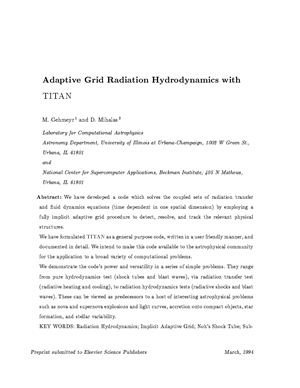Laboratory for Computational Astrophysics, University of Illinois,
National Center for Supercomputer Applications. Preprint submitted
to Elsevier Science Publishers, March, 1994, 47 pp.
We have developed a code which solves the coupled sets of radiation transfer and fluid dynamics equations (time dependent in one spatial dimension) by employing a fully implicit adaptive grid procedure to detect, resolve, and track the relevant physical structures.
We have formulated TITAN as a general purpose code, written in a user friendly manner, and documented in detail. We intend to make this code available to the astrophysical community for the application to a broad variety of computational problems.
We demonstrate the code's power and versatility in a series of simple problems. They range from pure hydrodynamics test (shock tubes and blast waves), via radiation transfer test (radiative heating and cooling), to radiation hydrodynamics tests (radiative shocks and blast waves). These can be viewed as predecessors to a host of interesting astrophysical problems such as nova and supeova explosions and light curves, accretion onto compact objects, star formation, and stellar variability.
We have developed a code which solves the coupled sets of radiation transfer and fluid dynamics equations (time dependent in one spatial dimension) by employing a fully implicit adaptive grid procedure to detect, resolve, and track the relevant physical structures.
We have formulated TITAN as a general purpose code, written in a user friendly manner, and documented in detail. We intend to make this code available to the astrophysical community for the application to a broad variety of computational problems.
We demonstrate the code's power and versatility in a series of simple problems. They range from pure hydrodynamics test (shock tubes and blast waves), via radiation transfer test (radiative heating and cooling), to radiation hydrodynamics tests (radiative shocks and blast waves). These can be viewed as predecessors to a host of interesting astrophysical problems such as nova and supeova explosions and light curves, accretion onto compact objects, star formation, and stellar variability.

